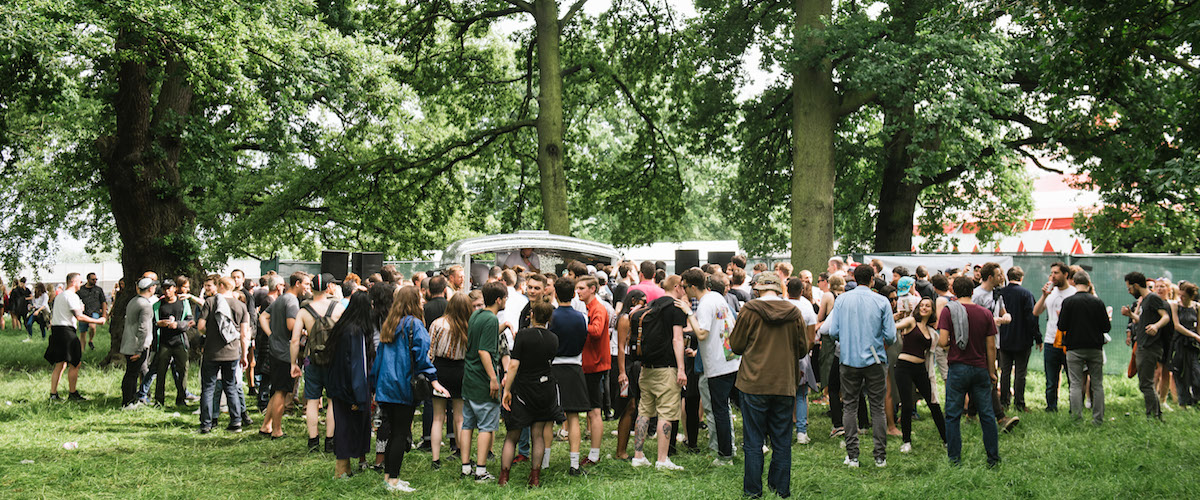Review and Photo Gallery: Found Festival
XLR8R visits South West London to check out this year's Found Festival.

I have never harboured much affection for London’s electronic music festivals. It sounds like a sweeping generalisation, criticising a plethora of largely successful events based solely on their location, but allow me to elaborate. I’ve had some of my finest musical experiences in the city, but the majority of these have occurred at a club rather than in one of the several parks or fields scattered across the city. There are several reasons for this, but it mostly comes down to three recurring themes: poor sound, short set times, and juvenile crowds. Having seen the lineup for this year’s Found Festival, which was perhaps one of the most well-curated I’ve seen in London for some time, I was optimistic upon my arrival in Brixton—but what I found was yet another event that fell at all the same hurdles.
Firstly, sound: as far as I am aware, a restriction of 92-94 decibels was strictly implemented for the entire duration of the day (i.e. from 11am – 9pm). One can only assume that this was down to the residential nature of the surrounding areas or to minimize the sound leakage from one tent to another. If it was the latter then it was ineffective nonetheless!
Independent of reasoning, however, it’s difficult to enjoy an electronic music event when the sound quality is so poor. Limitations of 92-94 decibels may work in an intimate indoor club environment where there are four stacks of speakers tightly enveloping the dancefloor, but it leaves much to be desired when there are only two sets positioned at the front pumping out music to an entire 3,000 capacity tent.
The result is a below-average musical experience for all, barring perhaps those few at the front who absorb all the sound. Admittedly the experience was slightly better during during the later sets on the Main Stage, but it was nothing short of terrible elsewhere. This was particularly noticeable on the Art of Dark stage where artists like Binh, Mara Trax (Maayan Nidam & Vera) and Petre Inspirescu all played in one of the largest tents of the event—a crazy decision in its own right. The sound was thin throughout the day, meaning that it was impossible to hear or appreciate the intricacies of their selections. Festivals such as Found should always seek the necessary permissions to ensure they can provide good sound before green-lighting anything.
Set times at festivals is something that interests me. The vast majority of electronic music festivals today employ the same system: DJs are limited to short slots, normally around two hours, though sometimes even less. Most sets at Found ranged from 60-90 minutes. On the face of it this is understandable: most festival crowds are different to club audiences in that they want to wander around and see a variety of artists rather than see a warm up and then a DJ play all through the night. Shorter set times also means more artists on the lineup, which inevitably appeals to wider audience. But as well intended as this may be, does it really work in practice? Does it really lead to a more enjoyable festival experience?
From my side, no. It may appeal to certain people in attendance—but it’s likely that many of these people are at one of their first music events and so want to dip in and out of sets. But for music fans, those who appreciate a good DJ set—and seemingly, based on the lineup, those who Found should appeal to—know that artists need time to express themselves behind the decks and so want lengthier set times. Is it really possible to see the best of Petre Inspirescu or Lucy in two hours? By adopting such rigorous measures Found is never going to really satisfy either audience.
And that leads us nicely onto my third point: the crowd at Found was young. I question whether I’ve seen so many football shirts in a field that doesn’t have two goals at either end. It wasn’t necessarily that they were rowdy or causing any harm, but having 19-year-old teenage girls screaming or filming on their iPhones is hardly conducive to a good atmosphere when watching some of the world’s finest artists ply their trade. Returning to my previous point above, this is an issue that seems especially evident in London, and one for which there is no immediately obvious solution.
If there is one, however, it is good music—and this is one thing that the festival must be given tremendous amounts of credit for.
It’s just a shame you couldn’t really hear much of it.
All photos: Marc Sethi.

